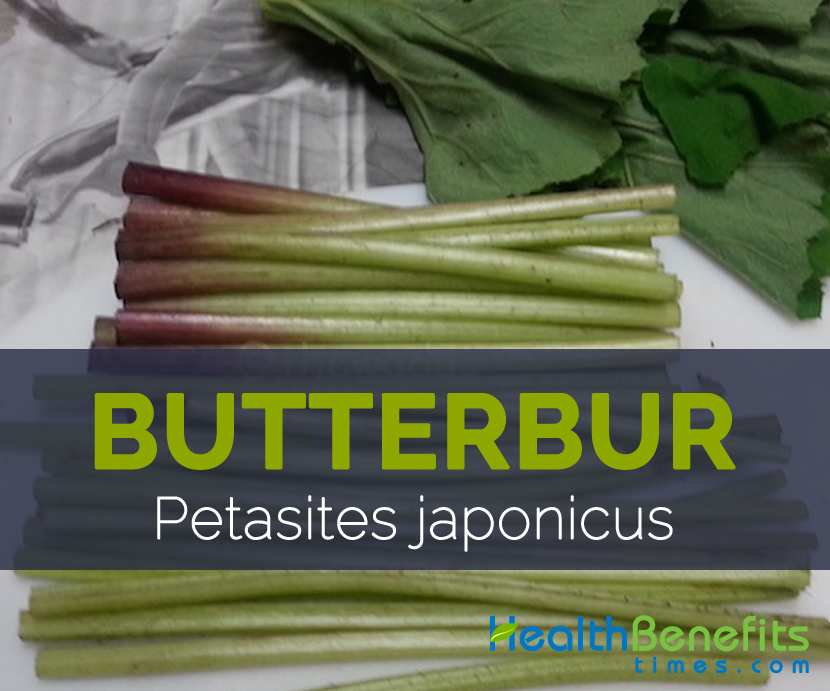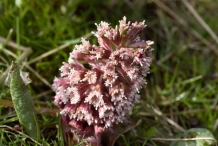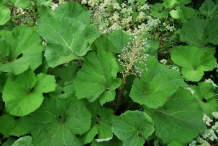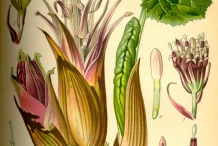| Butterbur Quick Facts | ||
|---|---|---|
| Name: | Butterbur | |
| Scientific Name: | Petasites japonicus | |
| Origin | Japan, Korea and China | |
| Colors | Light Green | |
| Shapes | Long slender | |
| Flesh colors | Light Green | |
| Calories | 8 Kcal./cup | |
| Major nutrients | Potassium (7.53%) Manganese (6.78%) Copper (6.56%) Calcium (5.90%) Vitamin B6 (4.00%) |
|
| Health benefits | Boosts Immunity, Prevents Asthma, Helps Treat High Blood Pressure, Thyroid Glands, Prevents Premenstrual Depression,Energy Support, Sugar level, Muscle disorders, Spasms and Pain,Reduce Fevers,Headaches, Allergic Reactions, Common Cold, Anti-Inflammatory Properties, Preventing migraine headaches | |
| Proximity | Amount | % DV |
|---|---|---|
| Water | 96.7 g | N/D |
| Energy | 8 Kcal | N/D |
| Energy | 33 kJ | N/D |
| Carbohydrate | 2.16 g | 1.66% |
| Protein | 0.23 g | 0.46% |
| Total Fat (lipid) | 0.02 g | 0.06% |
| Ash | 0.88 g | N/D |
| Minerals | Amount | % DV |
|---|---|---|
| Potassium, K | 354 mg | 7.53% |
| Manganese, Mn | 0.156 mg | 6.78% |
| Copper, Cu | 0.059 mg | 6.56% |
| Calcium, Ca | 59 mg | 5.90% |
| Magnesium, Mg | 8 mg | 1.90% |
| Selenium, Se | 0.9 µg | 1.64% |
| Iron, Fe | 0.1 mg | 1.25% |
| Phosphorus, P | 7 mg | 1.00% |
| Zinc, Zn | 0.09 mg | 0.82% |
| Sodium, Na | 4 mg | 0.27% |
| Vitamins | Amount | % DV |
|---|---|---|
| Water soluble Vitamins | ||
| Vitamin B6 (Pyridoxine) | 0.052 mg | 4.00% |
| Vitamin B9 (Folate, Folic acid) | 4 µg | 1.00% |
| Vitamin B1 (Thiamin) | 0.01 mg | 0.83% |
| Vitamin B2 (Riboflavin) | 0.01 mg | 0.77% |
| Vitamin B3 (Niacin) | 0.1 mg | 0.63% |
| Vitamin B5 (Pantothenic acid) | 0.018 mg | 0.36% |
| Folic Acid | 4 µg | N/D |
| Folate, DEF | 4 µg | N/D |
| Fat soluble Vitamins | ||
| Vitamin A, RAE | 1 µg | 0.14% |
| Vitamin A, IU | 27 IU | N/D |
Health benefits of Butterbur
Butterbur is an herbaceous perennial plant which grows mainly in deep fertile humus-rich soil that is permanently moist. Stems, rhizomes and leaves consists of nutritive value which is mainly used to heal numerous types of health ailments.
1. Preventing migraine headaches
Butterbur consumption is extremely beneficial to prevent migraine headache. Using a specific extract from the butterbur root over 16 weeks can decrease the number and harshness of migraine headaches and the length of time they last. Butterbur extract seems to decrease the number of migraine headaches by nearly half. Doses of at least 75 mg twice daily seem to be necessary for best results.
2. Anti-Inflammatory Properties
Nutrients presents in butterbur are extremely beneficial for the instant reduction of inflammation. As we all know that inflammation is one of the dangerous things in our body which must be cured on time otherwise it may wears down your body gradually. In case you are suffering from gout, arthritis as well as heart conditions, a prevailing anti-inflammatory treatment likes butterbur is required for the painless quick relief from the disease and and improve your long-term health.(1)
3. Common Cold
Butterbur is defined as one of the powerful expectorant, as it help to encourage the exclusion of phlegm and mucus through the respiratory tracts as well as nasal cavities. Phlegm and mucus are perfect places for bacteria to stay and develop, thus removing these hot spots for illness can speed the healing process if you are ill and avoid you from becoming ill if you’re healthy!(2)
4. Allergic Reactions
Allergic reactions are really a severe problem for many of us. If we go outside for few minutes it may bring dry itchy eyes, severe sneezing and a range of other indications. These types of physical symptoms are due to histamines released in our body when we meet a certain substance, even if it is harmless. Butterbur is an antihistamine element; therefore it can obviously prevent allergic reactions, or at least reduce their severity significantly.(3)
5. Headaches
Butterbur is used for the treatment of headaches and migraines. Isopetasin and petasin are two important chemical compounds directly related in decreasing the severity, symptoms and duration of a migraine, and these two prevailing chemicals are found in few species of butterbur. Due to this, every time talk to your herbalist and make sure that you are getting the proper butterbur variety to treat migraines.(4)
6. Reduce Fevers
Minimal amounts of butterbur are used to break fevers, thus speeding the healing process after an illness. Because of the anti-inflammatory nature of the herb, it is also a powerful immune system booster, due to its role in illness treatment.(5)
7. Spasms and Pain
Butterbur consists of certain anti-spasmodic and analgesic properties which do not get sufficient attention. If you have chronic pain, irritable bowels or are recovering from an illness or injury, small amounts of butterbur extract can help to clear up those conditions quickly, if used in suitable amounts.(6)
8. Muscle disorders
Potassium contained in butterbur plays a significant role in regular muscle contraction. A sufficient amount of potassium is essential for the regular contraction and relaxation of muscles. Most of the potassium ions present in human body is found in the muscle cells. It maintains optimum muscle and nerve function, and helps to keep our reflexes fast since it encourages the neural connectivity of muscles and the brain!
9. Sugar level
Butterbur consists of considerable amount of Manganese which showed effectiveness in controlling the level of sugar in human blood. It further prevents the occurrence of certain diseases like diabetes. To manage the level of sugar within the blood, manganese regularizes insulin synthesis as well as secretion. Unpredictable decrease of blood sugar can be better controlled, providing a more normal and functional life for diabetics.
10. Energy Support
Copper present in butterbur plays two main roles in energy production. Firstly it will help with combination of iron into red blood cells, avoiding anemia. Secondly it helps in generating energy from carbohydrates inside of cells. Both uses of copper require iron due to which symptoms of copper deficiency is just same of low iron intake symptoms. Sesame seeds and Lentils are few examples of World’s Healthiest Foods rich in both copper and iron.
11. Prevents Premenstrual Depression
Calcium which is present in butterbur is extremely beneficial to decrease the symptoms of premenstrual syndrome like hypertension, mood swings, dizziness and many others. Insufficient quantity of calcium may activate the release of the hormones which are liable for premenstrual mood swings as well as depression and irritability.
12. Thyroid Glands
Copper present in butterbur plays a significant role in ensuring the proper function of the thyroid gland. However, extra copper is also a main reason of thyroid malfunction, therefore you require a very balanced level of copper in the blood, otherwise hormonal activity will be imbalanced, and you can develop indications of either hyperthyroidism or hypothyroidism.
13.Helps Treat High Blood Pressure
Different research has proven that Vitamin B6 which is found in butterbur helps to reduce blood pressure in people who already have high blood pressure. Vitamin B6 helps to increase the blood flow, lowers build up in arteries as well as helps to prevents common issues of heart disease.
14. Prevents Asthma
People who have chronic asthma may be able to regularize their breathing with the help of magnesium supplements which help in relaxing the bronchial muscles as well as regulating breathing. Breathlessness and wheezing can be relieved through administration of intravenous magnesium.
15. Boosts Immunity
Research has concluded that selenium present in butterbur helps in proper functioning of the immune system, and may also be a main nutrient in counteracting the development of viruses like HIV. In patients who already contracted HIV, selenium has been displayed to be extremely valuable in slowing down the development of the disease into AIDS.
How to Eat
- Shoot can be chopped and stir fried with miso to make Fuki-miso that is consumed as a relish thinly spread over hot rice at meals.
- Bulb-like shoots are picked fresh and fried as tempura.
- In Korea, it is steamed or boiled and is pressed to eliminate water. Sesame oil or perilla oil is added in order to make namul.
- Leaf stalks are cooked and used as rhubarb.
- Stems are boiled and seasoned, pickled and used in winter soups or preserved in miso.
- Stem can be boiled, dipped in cold water then peeled and baked – they have a pleasing aromatic taste.
- Flower buds are cooked or used as a flavoring.
Other Traditional uses and benefits of Butterbur
- Plant is anti-asthmatic, anti-spasmodic, expectorant and poultice.
- Decoction is used in the treatment of long-lasting coughing and pulmonary ‘deficiency’, continuous sputum formation and pulmonary tuberculosis, labored or difficult breathing and asthma.
- It is usedas a folk medicine for the treatment of contusion, snakebites, wounds and furunculosis.
Other Facts
- Leaves of butterbur plant are used as umbrellas by Japanese children.
- Leaf stalks are also used as walking sticks.
- Plants can be grown as ground cover in moist shady places.
Precautions
- Butterbur consists of pyrrolizidine alkaloids (PAs) which have been related with cumulative damage to the liver and tumor formation.
- Butterbur can cause gastrointestinal issues, belching, drowsiness, headache, asthma, fatigue and itchy eyes.
- Butterbur may cause allergic reactions in people who are sensitive to plants like daisies, ragweed, marigolds and chrysanthemums.
Butterbur Facts
Butterbur is a herbaceous perennial plant mostly grows in moist shady position. It is 4 feet tall at maturity and is full of essential vitamins, minerals and other nutrients.
| Name | Butterbur |
|---|---|
| Scientific Name | Petasites japonicus |
| Native | Japan, Korea and China |
| Common/English Name | Fuki, bog rhubarb, Sweet Coltsfoot, giant butterbur ,Japanese sweet coltsfoot |
| Plant Growth Habit | Herbaceous perennial plant |
| Growing Climate | Moist shady position, stream banks, Invades forests, and other moist, low-light environments. |
| Soil | Deep fertile humus-rich soil that is permanently moist but not stagnant |
| Plant Size | 4 feet tall at maturity, with a spread of 5 feet |
| Leaf | Flowering stem leaves: stalkless, scale-like, ovate, with rounded tip, light green.
Vegetative leaves: blade kidney-shaped,long-stalked up to 80 cm (32 in.) irregularly toothed,wide, underside thinly hairy, upper surface nearly glabrous, basal lobes along with rounded tip, bent towards each other. |
| Leaf Stalk color | Light Green |
| Leaf Stalk Shape and Size | Long slender |
| Flowering Season | February |
| Flower | Yellow to white inflorescences on flowering stems up to 50 inches tall. Bloom in compound bunches resembling an umbrella |
| Fruit shape & size | Achene with unbranched hairs on tip. Fruits do not form in Finland |
| Stalk Flavor/aroma | Bittersweet flavor |
| Varieties/Types | Mizubuki, Aichi-wase-buki and Akita-buki |
| Season | March |
| Major Nutrition | Potassium, K 354 mg (7.53%) Manganese, Mn 0.156 mg (6.78%) Copper, Cu 0.059 mg (6.56%) Calcium, Ca 59 mg (5.90%) Vitamin B6 (Pyridoxine) 0.052 mg (4.00%) Magnesium, Mg 8 mg (1.90%) Carbohydrate 2.16 g (1.66%) Selenium, Se 0.9 µg (1.64%) Iron, Fe 0.1 mg (1.25%) Phosphorus, P 7 mg (1.00%) |
| Health Benefits |
|
| Calories in 1cup (145gm) | 8 Kcal |
References:
https://en.wikipedia.org/wiki/Petasites_japonicus
http://www.pfaf.org/user/Plant.aspx?LatinName=Petasites+japonicus
https://www.rhs.org.uk/Plants/12568/Petasites-japonicus/Details
http://www.luontoportti.com/suomi/en/kukkakasvit/japanese-butterbur
https://nccih.nih.gov/health/butterbur





